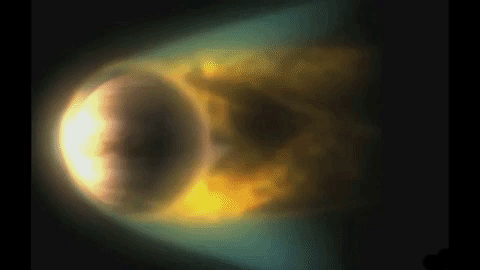The hellish planet Venus may have had a perfectly habitable environment for 2 to 3 billion years after the planet formed, suggesting life would have had ample time to emerge there, according to a new study.
A study presented at the EPSC-DPS Joint Meeting 2019 by Michael Way of The Goddard Institute for Space Science gives a new view of Venus’s climatic history and may have implications for the habitability of exoplanets in similar orbits. Venus may have been a temperate planet-hosting liquid water for 2-3 billion years until a dramatic transformation starting over 700 million years ago resurfaced around 80% of the planet.
In 1978, NASA’s Pioneer Venus spacecraft found evidence that the planet may have once had shallow oceans on its surface. Since then, several missions have investigated the planet’s surface and atmosphere, revealing new details on how it transitioned from an “Earth-like” planet to the hot, hellish place it is today.
To see if Venus might ever have had a stable climate capable of supporting liquid water, Dr. Way and his colleague, Anthony Del Genio, have created a series of five simulations assuming different levels of water coverage.
In all five scenarios, they found that Venus was able to maintain stable temperatures between a maximum of about 50 degrees Celsius and a minimum of about 20 degrees Celsius for around three billion years. A temperate climate might even have been maintained on Venus today had there not been a series of events that caused a release, or ‘outgassing’, of carbon dioxide stored in the rocks of the planet approximately 700-750 million years ago.
Three of the five scenarios studied by Way and Del Genio assumed the topography of Venus as we see it today and considered a deep ocean averaging 310 metres, a shallow layer of water averaging 10 metres and a small amount of water locked in the soil. For comparison, they also included a scenario with Earth’s topography and a 310-metre ocean and, finally, a world completely covered by an ocean of 158 metres depth.
To simulate the environmental conditions at 4.2 billion years ago, 715 million years ago and today, the researchers adapted a 3-D general circulation model to account for the increase in solar radiation as our Sun has warmed up over its lifetime, as well as for changing atmospheric compositions.
Although many researchers believe that Venus is beyond the inner boundary of our Solar System’s habitable zone and is too close to the Sun to support liquid water, the new study suggests that this might not be the case.
At 4.2 billion years ago, soon after its formation, Venus would have completed a period of rapid cooling and its atmosphere would have been dominated by carbon-dioxide. If the planet evolved in an Earth-like way over the next 3 billion years, the carbon dioxide would have been drawn down by silicate rocks and locked into the surface. By the second epoch modelled at 715 million years ago, the atmosphere would likely have been dominated by nitrogen with trace amounts of carbon dioxide and methane (similar to the Earth’s today) and these conditions could have remained stable up until present times.
The cause of the outgassing that led to the dramatic transformation of Venus is a mystery, although probably linked to the planet’s volcanic activity. One possibility is that large amounts of magma bubbled up, releasing carbon dioxide from molten rocks into the atmosphere. The magma solidified before reaching the surface and this created a barrier that meant that the gas could not be reabsorbed. The presence of large amounts of carbon dioxide triggered a runaway greenhouse effect, which has resulted in the scorching 462 degree average temperatures found on Venus today.
There are still two major unknowns that need to be addressed before the question of whether Venus might have been habitable can be fully answered. The first relates to how quickly Venus cooled initially and whether it was able to condense liquid water on its surface in the first place. The second unknown is whether the global resurfacing event was a single event or simply the latest in a series of events going back billions of years in Venus’s history.
These findings are encouraging for those who believe that extra-terrestrial life exists. Think about it, if Venus had not undergone a massive resurfacing event (or a series of them), humanity would have only needed to look next-door for proof of extra-terrestrial life. It could have produced life of its own that would still be around today. Our one Solar System could have had not one, but two life-bearing planets.
These findings are likely to be encouraging for those who believe that Venus should be terraformed someday. Knowing that the planet once had a stable climate, and could maintain it despite its orbit, effectively means that any ecological engineering we do there would stick.
That means that Venus could someday be made into a balmy world that’s mostly covered with oceans with few large continents and extensive archipelagos.
